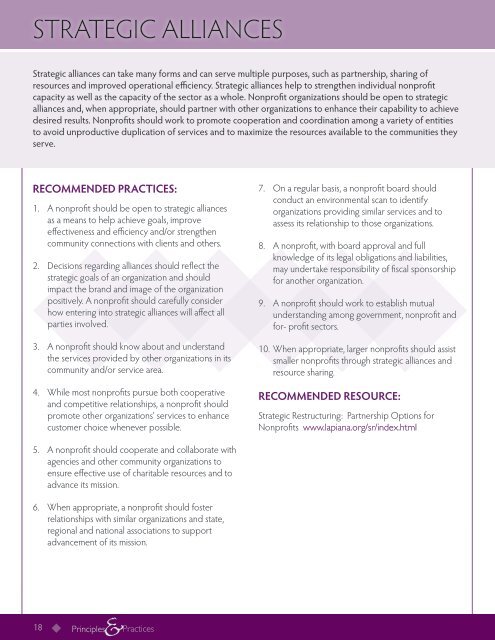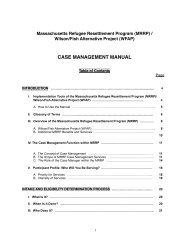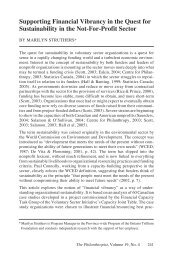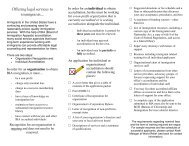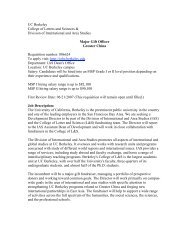Principles & Practices for Nonprofit - NNAAC
Principles & Practices for Nonprofit - NNAAC
Principles & Practices for Nonprofit - NNAAC
You also want an ePaper? Increase the reach of your titles
YUMPU automatically turns print PDFs into web optimized ePapers that Google loves.
STRATEGIC ALLIANCES<br />
Strategic alliances can take many <strong>for</strong>ms and can serve multiple purposes, such as partnership, sharing of<br />
resources and improved operational efficiency. Strategic alliances help to strengthen individual nonprofit<br />
capacity as well as the capacity of the sector as a whole. <strong>Nonprofit</strong> organizations should be open to strategic<br />
alliances and, when appropriate, should partner with other organizations to enhance their capability to achieve<br />
desired results. <strong>Nonprofit</strong>s should work to promote cooperation and coordination among a variety of entities<br />
to avoid unproductive duplication of services and to maximize the resources available to the communities they<br />
serve.<br />
RECOMMENDED PRACTICES:<br />
1.<br />
2.<br />
3.<br />
4.<br />
5.<br />
6.<br />
18<br />
A nonprofit should be open to strategic alliances<br />
as a means to help achieve goals, improve<br />
effectiveness and efficiency and/or strengthen<br />
community connections with clients and others.<br />
Decisions regarding alliances should reflect the<br />
strategic goals of an organization and should<br />
impact the brand and image of the organization<br />
positively. A nonprofit should carefully consider<br />
how entering into strategic alliances will affect all<br />
parties involved.<br />
A nonprofit should know about and understand<br />
the services provided by other organizations in its<br />
community and/or service area.<br />
While most nonprofits pursue both cooperative<br />
and competitive relationships, a nonprofit should<br />
promote other organizations’ services to enhance<br />
customer choice whenever possible.<br />
A nonprofit should cooperate and collaborate with<br />
agencies and other community organizations to<br />
ensure effective use of charitable resources and to<br />
advance its mission.<br />
When appropriate, a nonprofit should foster<br />
relationships with similar organizations and state,<br />
regional and national associations to support<br />
advancement of its mission.<br />
& <strong>Principles</strong> <strong>Practices</strong><br />
7.<br />
8.<br />
9.<br />
On a regular basis, a nonprofit board should<br />
conduct an environmental scan to identify<br />
organizations providing similar services and to<br />
assess its relationship to those organizations.<br />
A nonprofit, with board approval and full<br />
knowledge of its legal obligations and liabilities,<br />
may undertake responsibility of fiscal sponsorship<br />
<strong>for</strong> another organization.<br />
A nonprofit should work to establish mutual<br />
understanding among government, nonprofit and<br />
<strong>for</strong>- profit sectors.<br />
10. When appropriate, larger nonprofits should assist<br />
smaller nonprofits through strategic alliances and<br />
resource sharing.<br />
RECOMMENDED RESOURCE:<br />
Strategic Restructuring: Partnership Options <strong>for</strong><br />
<strong>Nonprofit</strong>s www.lapiana.org/sr/index.html


